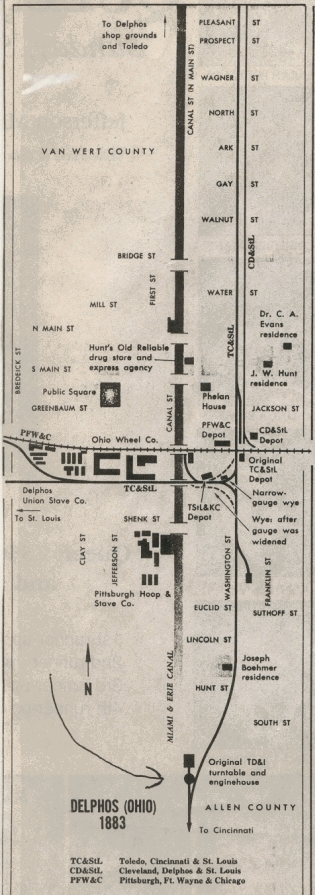

Window to the Past
A narrow-gauge railroad
By BOB HOLDGREVE
I am researching the history of the former railroad on Washington Street that was torn out this year. It started out as the Toledo, Delphos & Indianapolis, and after many name changes and mergers, ended with the most recent name being the Norfolk & Western (N&W) Railroad.
To get an idea of why there was such a rush to build narrow gauge railroads in the 1870's and early 1880's, we need to know that at that time there was mainly lumber industries, plus farm products and other businesses that needed a way to transport their goods to more markets, thus receiving a better price.
The railroads would reach big cities such as Toledo, Indianapolis, St. Louis, Cincinnati and many other areas. Also they would connect to other narrow-gauges that entered the coal fields and stone quarries of Ohio and Indiana. The Toledo, Delphos, & Indianapolis narrow gauge (three feet width) was estimated to cost $8,000 per mile, built and equipped, versus a standard gauge, (four feet, eight and one half inches width) at least three times that amount.
On March 14, 1872, four leading Delphos businessmen organized the T.D. & I. Railroad. Because of a money panic in 1873, they had to delay building the railroad until April 1877, when the ground was broken in Delphos.
On April 12, 1877 some parts of an ordinance for laying a track on Washington Street states, Section 3 - First, that the construction of the tracks and switches and the keeping of the same in repair, shall be under the direction of the City Civil Engineer or such other officer of said Incorporated Village as the Common Council may designate.
Section 3 - Sixth, When property holders shall desire a crossing over the said tracks at points where the street is not paved, the said company shall make plank crossings of oak of the proper length.
Section 6 - If at any time, the tracks, switches and siding shall be abandoned, such tracks and all other improvements made on the street shall become the property of the village, and to be disposed of as the Common Council may desire.
On May 3, 1877, The Delphos Herald files stated: We took a look over the line of the Toledo, Delphos and Indianapolis Narrow-Gauge between Delphos and Fort Jennings last Friday. We confess to an agreeable surprise at finding the construction of the most substantial character. In a distance of five miles, the line crosses the wagon road (Fort Jennings Road) no less than five times, and at all the crossings, permanent and durable cattle-guards have been placed. The bridges are in position and present the most solid appearance. The work is going ahead in a gratifying manner, and soon the sound of the locomotive will be heard in the timber regions north of us.
May 31, 1877 Delphos Herald stated: Delphos alone has raised over one hundred thousand dollars. Her enterprise and pluck has made a young and thriving city out of a mudhole.
An engine house for the T.D. & I. Narrow-Gauge has been put up on Greenbaum Street (First Street) between Canal Street (Main Street) and Washington Street.
The first section of the T.D. & I. will run from the P.F.W. & C. at Delphos to the B&O at Holgate.
May 31, 1877, Delphos Herald: L. Bochmer and T.H. Klekamp inform all those indebted to them that they can liquidate their debt by delivering ties on said road, for which 15 cents per tie will be allowed. Ties to be six feet long, six inches face, and five inches thick - sound burr or white oak, walnut or red elm.
July 5 Delphos Herald: Delphos celebrates the Fourth of July and the formal opening of the T.D. & I. Railway. To get a good start, the people commenced celebrating on the evening of the third, when the Germania Band appeared upon the streets and discoursed some excellent music. The urchin with the firecrackers filled the air with "sound and fury." On the Fourth, the celebration was moved to Fort Jennings in commemorating the town's historic past.
The T.D. & I. train, made up of eight cars drawn by a 12-ton engine, made nine trips to Fort Jennings, carrying over 5,000 people. Although thunderstorms thwarted a battery of orations, Professors Pangle and Cordell managed several balloon ascensions, and the fireworks display rivaled that of the centennial celebration. A patriotic parade was led by the Germania Band, after which the crowd quickly disposed of a monumental supply of beer. The amiable folks of Fort Jennings treated their visitors to a formidable cache of the town's principal export, corn whisky. All-in-all it was a memorable Fourth.
Compiled by Robert Holdgreve
President of Delphos Historical Society
September 12, 1998 Delphos Herald Newspaper


'Narrow-gauge' fever
By BOB HOLDGREVE
Delphos Herald Nov. 15, 1877. A correspondent of the St. Marys Free Press has the following to say:
"Having had occasion to traverse the narrow-gauge railroad from Delphos to Dupont, and seeing the line at its worst; and its patrons when most disposed to grumble according to the condition of human nature. A word or two relative to my experience may prove timely, especially as the 'narrow-gauge' fever seems to have struck in this neighborhood. There was a spell of bad weather on my trip over the road above referred to; the passenger coach was smeared with mud, and reeked with tobacco smoke and with fumes from the oozy garments of the rough timber men and tracklayers. A red hot stove was in the center of the car. A cold rain was falling; darkness setting the train an hour behind time. The train was compelled to stop every three or four-miles to get up stream, owing to the wet fuel at hand, all in all a combination of circumstances to give one a slanting view of any enterprise under the sun. However that bright little pony engine named the Dupont, stuck to its task like a sick kitten to a warm brick, snaking the train through all right. Our train consisted of seven freight cars heavily loaded with hickory butts, stave bolts, and saw-logs, in addition to the baggage and passenger cars. This was the heaviest load, five to six tons per car; the worst condition of track and of fuel, and the worst time yet experienced on the road. Yet on every hand was heard only commendations of the enterprise. It was evident that with half way decent fuel, the engine would have performed its task with perfect ease and on time. The charge per car over the 16 miles is only $3, add to this fact that its advantages are accessible three times per day, going and coming, for freight or for passengers, for any train will stop any person anywhere if only to carry him one mile. A narrow-gauge is worth to its patrons a dozen wide track railroads."
From Delphos Herald Jan. 31, 1878
"Wednesday evening, Jan. 23, prompted by business and a desire to see
the country, we took a trip by buggy along the proposed Delphos and Kokomo
narrow-gauge to Willshire.
"The thermometer was low the next morning and the roads were bare and rough. We proceeded to Mr. Lockard's stable and procured a first-class rig, and off we went, striking for the ridge road, but before we reached the corporation line we felt that, hopping to one side of the road to the other over clods of frozen dirt, would be too much, and as luck would have it, one of the tugs slipped out of the single-tree when we turned around, so we put up the horses in time to take the 11:30 train as far as Van Wert, at which place we procured a team and was soon again on our way. We arrived at Willshire at dusk, tired and muddy.
"After attending to our business and a good long talk - mostly narrow-gauge - and a good night's rest, we started for home. When a mile out of town, our buggy broke down, compelling us to go back to Willshire on foot, where we procured another buggy and again proceeded on our way, arriving safely at Van Wert without any more misshape, being well satisfied with what we saw and heard - outside of the mud and the voice of the driver.
"Along the road we found a most beautiful country - rich farming lands, large clearings, and farms with brick residences and large barns. The corn shocks were tall, indicating the richness of the soil; lots of fat hogs and herds of sheep and cattle. The woods were lined with valuable timber, valuable if on a line of a railroads which could convey it to a market, but worthless without it. Large tracts of white oak, elm and hickory, were deadened, to prepare them for the log heaps and a ready destruction by fire. We saw woods with butts enough on them to readily pay for the land if they could be easily brought to our factories or factories could be located there near a shipping line.
"Near Willshire we met an old-fashioned drove of hogs, destined for Decatur, Ind., nine miles away, for shipment to Cincinnati. One driver told us that he had bought 13,000 hogs this season. What work, time and expense it takes to drive these fat hogs from nine to 16 miles over these roads, say nothing of the improper language used, not becoming a civilized Christian nation, while 100 narrow-gauge cars could convey them to Toledo, a better market than Cincinnati, in less time and less expense than it takes to drive them to the nearest standard gauge railroad point. Adam Strobinger, our landlord at Willshire, informed us that when the roads are half way passable, from 18-20 teams in a string, loaded with grain, can be daily seen passing his house for Decatur.
"It requires special mention that every farmer can count on 10-20 percent additional on each dollar worth of grain or stock he may have for sale, and a ready market for timber, which is now worthless. A farmer living some 10 miles away on the completed line of the Toledo, Delphos, & Indianapolis Railway and has experienced the good results, says "Let everyone do their duty and this important enterprise will succeed."
From Delphos Herald Feb. 7, 1878
"Hon. Moses Bradford, of Bradford Station, North Marion, Ind., who
recently visited Delphos for the purpose of taking a look at our narrow-gauge
railway, gives his observations in the following communication:
"I went to Delphos, Ohio, to see and learn all about the narrow-gauge railroad. Arriving there, instead of a small town, I found quite a manufacturing place, especially of wood. There are about eight or 10 establishments, manufacturing staves, heading, whiffletrees, neck yokes, etc. It is a nice little city of about 4,000 inhabitants. I met with a cordial greeting and a friendly people. We went to the bank of Joseph Boehmer, and from there to the railroad office where I met Mr. Williams and Dr. Evans. They are all very intelligent and friendly gentlemen. I also met several others of a very fine residence. Early on the following morning we took the narrow-gauge train north on the new road for 16 miles. Our train consisted of nine flat cars, a caboose, and a 12-ton engine. They make two trips a day, out and back, bringing in timber, and make about $165 per week, which is sufficient to pay all ditchers, section hands, engine men, interest, expenses of every kind, and leave $65 clear every Saturday night. Now if one engine and eight flat cars do so well, what would two do? The flat cars are so light and run so easy that one man can push two of them with ease. When cars are left to be loaded, they would be put off while the train was running, and two men would take hold of the posts, and stop them, and have them loaded by the time the train returned from the trips. Coming back out of that flat and terrible woods, they had 26 passengers. From Delphos north there are 16 miles done, and one fine bridge built over the Auglaize River, three spans in length, each span 100 feet, a good bridge, and a good road.
"At Delphos the cars will run up to the canal, so that they can load and reload directly from the boats.
"Now one word of caution to the people of Grant County. Look out for that little engine, for it doesn't make much noise. It might run over you."
Delphos Herald - Apr. 4, 1878
"Mr. J. W. Hunt, the contractor, broke ground on the southern extension
of the Toledo, Delphos, and Indianapolis narrow-gauge last Monday. A force of
hands were put to work on a division of three miles, starting near the P., Ft.
W. & C. railroad and extending south. A gang of hands also started out from
Spencerville to grade the line between that point and Mendon. It is intended to
run the cars over the road to Mendon by the Fourth of July. We congratulate out
Spencerville and Mendon neighbors on their immediate prospects of railway
intercourse with the metropolis of Delphos."
From Delphos Herald, June and July 1877
The following individuals have paid their subscription to the capital stock
of the Toledo, Delphos and Indianapolis Railway:
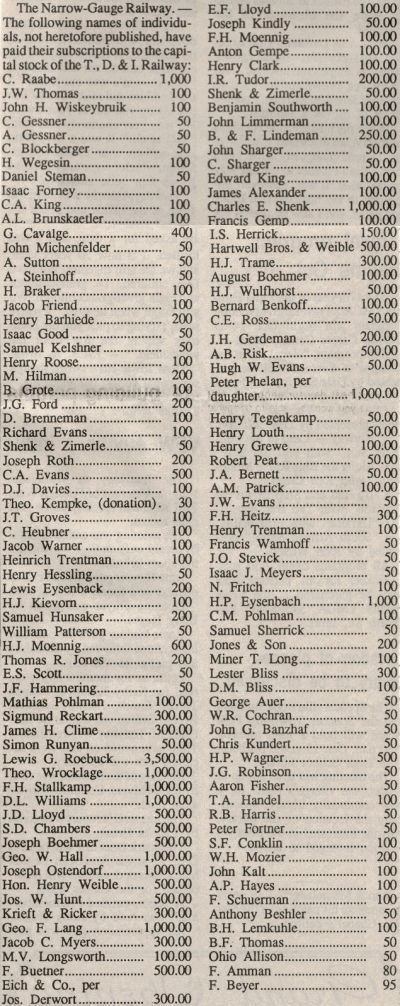
Compiled by Robert Holdgreve
President of Delphos Historical Society
October 10, 1998 Delphos Newspaper
Editor's note: Bob Holdgreve continues to write about the railroad in the Delphos area in the 1800s.
Sept. 19, 1878 - Delphos Herald.To Herald Editor - You and your many readers have expressed a desire to know something concerning the country between Dupont and Holgate. Allow my feeble pen to present a few sketches.
Starting north from Dupont, the T.D. and I. Co. have laid and ballasted as fine a new road as any human desires to lay eyes on. The almost impenetrable forest on both sides of the track are the densest imaginable, and beggar description; verily, the thickest woods on earth. How a company of men could gather grit enough to build a railroad through such a country should astonish all.
To divert a little, I must tell you something about Kiefersville. This rathole on the swamp got left out on the narrow-gauge business by an overdose of Howardism, (was bypassed for Howard), and now is trying to get even with the world.
A young man was taken sick with the ague while working on the railroad. He went over to Kiefersville and got a dose of quinine which he took during his fever. This made him delirious and the whole gang of Phillistines at Kiefersville decided that the young man must be crazy. Instead of judging him a lunatic and sending him to the asylum, they took him before a Justice of the Peace who fined him $10 and cost.
Several miles further north we get to Powell's Creek. To the casual observer, this part of the country would have made a good place for Noah to build his ark. Lytle and Co. built a sawmill here but some unprincipled farmers went to work and dug a ditch 24 feet wide, which drains the water from the locality. This proceeding takes the wind out of the ark business. Two miles from Powell's Creek, we reach Popular Ridge. This is a ridge that is about four miles wide, and some people say, reaches from New York to Chicago. I am inclined to believe this statement, as the inhabitants of this ancient burg walked over the ridge from New York here when they crossed the ocean four hundred years ago. The people living in this neck of the woods are certainly the most peculiar under God's canopy. They can't agree on partition fences - so every man builds fences on his own ground. We sincerely trust that the advent of the iron horse and civilization will work a change in these people and that some of the older-ones will get their hair cut. Go 3 1/2 miles to Holgate and you will be at the terminal of the T.D. and I. which will make a connecting link between the monster trunk lines of the B. and O. and the Pennsylvania at Delphos. Mr. Editor if I live to stand the shock of reading the above in print, you shall hear again from Jay Hawker.
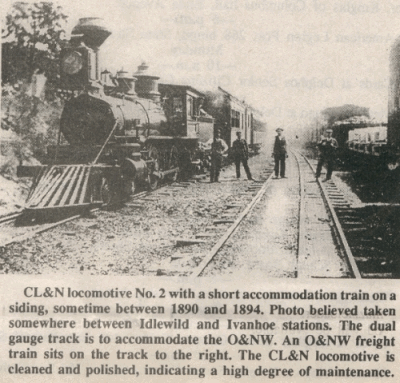
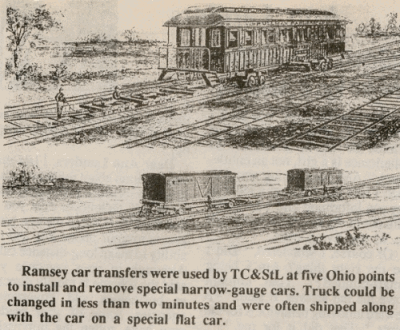
From The Nickel Plate Story by John Rehor.
Although the Delphos and Kokomo subscriptions stipulated that the road was to be completed by the end of 1878, it was not until Jan. 24, 1879, that the last rails were spiked down at Willshire. The inaugural run was made three days later. A small enginehouse was built at Willshire, a coach purchased, and a mixed train put on a daily, except Sunday, schedule. Though the schedules required an average speed of only seven miles per hour, the D and K's Baldwin engine seldom got over the road without jumping the track at least once. Still little Willshire was highly pleased with its new railroad as evidenced by this dispatch from the town: Old Willshire has thrown off her lethargy and is up and doing, everything is activity-- and all this is due to the Delphos and Kokomo Railway which now affords us the boon so long denied us--communication with the civilized world.
The Delphos, Bluffton, and Frankfort Railroad was incorporated and connected with the Delphos and Kokomo at the Indiana state line and ran to Kokomo, being completed on October 1878.
On May 23, 1879, the Toledo, Delphos, and Indianapolis; Delphos and Kokomo; Delphos, Bluffton, and Frankfort; and the Toledo and Maumee were consolidated to form the Toledo, Delphos, and Burlington Railroad. On Dec. 16, a new Baldwin engine left Warren, Ind. with four coaches at 7 a.m. and arrived in Delphos at 1:30 p.m., whereupon Carey Evans led 120 thirsty passengers to Ben Hoerstman's Narrow Gauge Saloon. The end of the local management of the T.D. and B. came with tragic suddenness on Sept. 2, 1879. On that day, Joseph Hunt was killed as he stepped between two box cars on the PFW and C sidetrack at Delphos.
The TD and B's small 0-4-0 engine was relegated to yard duty at Delphos in 1880. Even there the little wood burner had a propensity for jumping the track, and on one occasion ended up on its back in a creek bed. On another unhappy day, a Delphos factory burned to the ground after the Baldwin showered it with sparks. Finally a careless engineer launched the engine through an open draw bridge into the Miami and Erie Canal where it tied up both the narrow-gauge and the canal for several days. Once retrieved, the engine was taken to the Delphos shop and dismantled.
When the TD and B moved its general offices to Toledo in Nov. 1880, Delphos began a determined campaign to secure the road's main repair shops. When Bluffton, Indiana's bond issue failed to get past the voters, the Delphos city fathers got the shops by granting the TD and B 12 acres of land and $30,000 cash. In August 1881, the TD and B completed a new 10-stall roundhouse and a 60x90 foot blacksmith shop about a mile north of the PFW and C depot. During the summer of 1882, a 130x80 foot machine shop with six pits was added. By late 1882, the shops were employing more than 200 men.
End of the Narrow-Gauge
From "The Nickel Plate Story" By JOHN REHOR
On Feb. 23,1882, the Toledo, Delphos and Bluffton directors voted to consolidate with the Toledo, Cincinnati and St. Louis Railroad and use the latter name. The T.C. & St. L's promoters billed it as "the 'Little Giant Line,' the narrow gauge system which aims to consolidate all the three-foot gauge roads into one great and connecting chain, which shall reach from the Atlantic to the Pacific."
The beginning of the end came July 1883, when a minor creditor petitioned for a receiver. Less than a third of the road was ballasted and hardly as much was fenced. Along the older part of the system, many trestles were rolled out and unsafe to run trains across. The employees had not been paid since May and in July the 200 shopmen at Delphos had refused to continue work without pay. After June 1884, the receiver continued to operate the T.C. & St.L. between Toledo and East St. Louis. On Jan. 6, 1885, all trains were discontinued save for a single mixed run in each direction. All but 20 shopmen at Delphos were furloughed.
The depression winter of 1884-85 found most of the narrow gauge railroaders of Delphos leading a wretched hand-to-mouth existence. Many headed south when word came that the Florida Southern narrow-gauge was hiring. Those who stayed behind and were fortunate enough to have jobs, were paid in receiver's certificates in lieu of cash. At best they could be redeemed at the rate of 35 to 50 cents on the dollar.
Delphos merchants were forced to "carry" the railroad men for months at a time. The Little Giant was all but defunct and in such a sorry state of deterioration that men who accepted a call assumed a terrible risk. Mixed trains out of Delphos and Toledo exchanged loaded cars at the Auglaize River bridge one at a time, using empty cars as idlers. The timbers of the bridge were so badly rotted that the railroad did not dare to run even the lightest engines across it.
At the insistence of the bondholders, a new receiver was named in July 1856, and the affairs of the railroad took a turn for the better. Repairs were made to the Dupont bridge and for the first time in two years the employees were paid in cash.
Without having anticipated it, the railroad was suddenly blessed with an incredible well-timed stroke of good fortune. The huge Karg gas well completely altered, the destiny of the moribund Toledo, Cincinnati & St. Louis railroad. In February 1886, a few weeks after the great gas well was brought in at Findlay, gas was also discovered near Delphos. As far as the railroad was concerned, the gas boom created a receptive market for the securities they had to sell. Toledo soon became the "glass capital of the world."
On June 12, 1886, the Toledo, Cincinnati & St. Louis and two other railroads were consolidated to form the Toledo, St. Louis & Kansas City railroad. This name being too long to be conveniently handled when mentioned, some kind of trademark or "pet name," was sought. A new title was given, hereafter known as the "Clover Leaf" route. This rural and romantic pet name is said to be significant of the fertile country through which the railroad runs, and the good luck that has finally attended it.
By October 1886, six construction trains were used between Frankfort Indiana, and Toledo. More than 600 men were employed, spiking 615 pound rail to new white oak cross-ties. Spikes were driven at the outer ends of the ties so that one set of rails could be quickly moved into place when the time came to widen the track from narrow-gauge to standard. Many trestles were rebuilt and new iron bridges were erected. At dawn on Sunday June 26, 1887, construction trains steamed out of Delphos, Toledo and Frankfort. More than 2,000 men working in gangs of 40 undertook the work of changing the gauge to standard. Blessed with perfect weather, they had the entire job done by nightfall. The first standard-gauge passenger train left Delphos for Frankfort at 5 a.m. on June 27.
In July 1888 the Delphos shops began rebuilding the first of about 20 narrow-gauge locomotives. During 1889 and 1890, 11 Hinkley 2-6-0s and Forneys were rebuilt as yard goats. Some of these were rather ridiculous looking machines. One of the rebuilts that labored in the Delphos yard was rudely described by the local newspaper as "old flint-lock, not a sweet bird at all."
Much to the chagrin of Delphos, the Clover Leaf tried mightily to forsake its birthplaces. They sought a more centralized location for a new set of repair shops. In June 1892, new shops were completed at Frankfort. The loss of the locomotive shops to Frankfort, was a bitter pill for Delphos to swallow. With the supply of hardwood timber nearly exhausted, most of the, woodworking factories had been closed and the loss of the Delphos shop payroll would have been a calamity. In 1890 the Clover-Leaf mollified the vexed city fathers by making a contract with the New York Equipment Company to repair second-hand locomotives. In October of that year, the first large group of engines arrived at Delphos. There were 23 New York Central engines en route to the Mexican government. At times during the 1890s there were as many as 30 foreign locomotives awaiting overhaul at the shops.
One of the first railroads to go under during the financial storm of 1893, was the Clover Leaf. On March 27, 1900, it was sold to its bondholders for 12.2 million dollars. A new company, the Toledo, St. Louis & Western Railroad was incorporated and kept the Clover Leaf name.
The maverick Clover Leaf got along famously with the interurbans. Lacking branch-line feeders of its own, they filed joint passenger tariffs with a number of traction lines and capitalized on their low fares. In January 1905 the Dayton and Troy Electric inaugurated its "Clover Leaf Special," a daily run between Dayton and Delphos by way of Troy, Piqua Wapakoneta and Lima. It left Dayton each afternoon at 5:18 and covered the 95 miles to Delphos in 2 hours and 34 minutes. This was then the fastest long-distance interurban run in the United States.
The amazing performance of the Clover Leaf past freights was achieved by an elite corps of enginemen who surely must have had ice water in their veins. One of them, Morgan Meier, became a living legend, after making a futile bid to save his mortally injured conductor, by running an engine backward at breakneck speed all the way from Silverwood to Frankfort. At the throttle of one of the Rock Island 19X24s, Meier made the tortuous 58 mile trip in 50 minutes. In this remarkable feat he set a speed record for that section that has never been equaled.
After foreclosing on the Toledo, Cincinnati & St. Louis the (Little Giant), it took the courts more than 15 years to unravel the complex, corporate structure. The division south of Delphos, after two or three name changes, was absorbed by the Cincinnati, Hamilton & Dayton. They promptly set about to widen the gauge of the Dayton to Delphos line. The first standard gauge train ran over this section on July 13, 1891. The C.H. & D. line between Stillwater Junction, near Dayton, and Delphos was operated as the Dayton, Toledo & Chicago Railroad from about 1916 to 1922 when it was abandoned. The Nickel Plate acquired 3664 feet of this track and a small yard at Delphos.
On March 9, 1926, a devastating fire destroyed much of the shop building at Frankfort, throwing more than 600 men out of work. While the facility was being rebuilt, it was necessary to reopen the old narrow-gauge shop at Delphos.
On Oct. 16, 1964, Nickel Plate merged with Norfolk and Western.
Following is a list of railroads with Delphos in their name. Several might not have gone into actual construction after incorporating.
Delphos, Bluffton, & Frankfort;
Delphos & Kokomo;
Toledo, Delphos & Indianapolis;
Toledo, Delphos & Burlington;
Cleveland, Delphos & St. Louis;
Delphos Southern Railway Co.;
Delphos Northern Railroad;
Delphos & Paulding Railroad Inc.
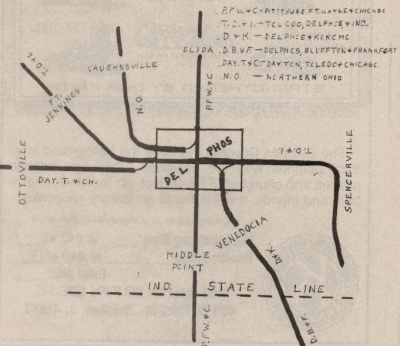
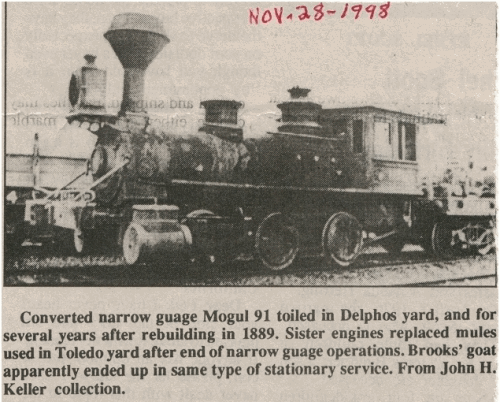
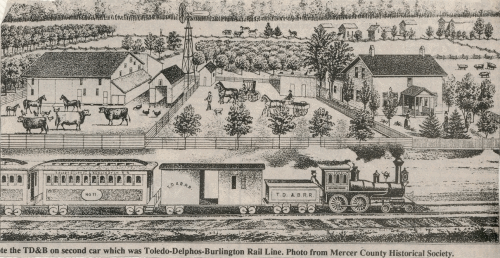
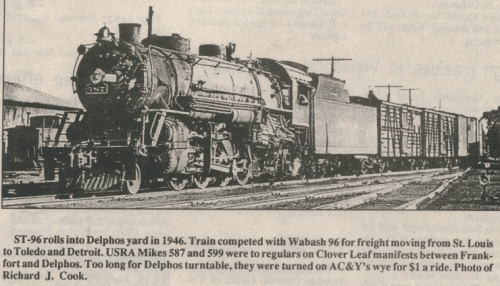
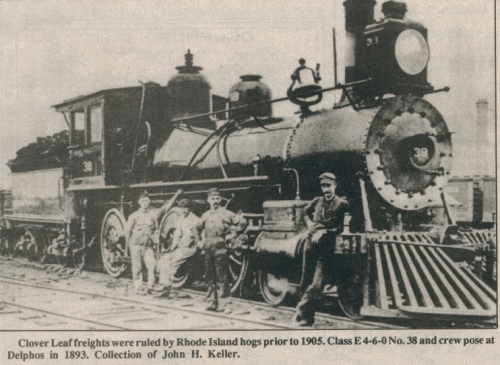
Compiled by Robert Holdgreve
President of Delphos Historical Society
December 19, 1998 Delphos Herald Newspaper